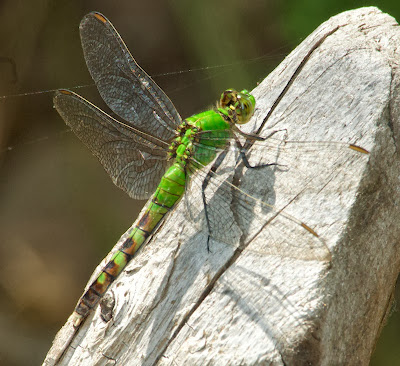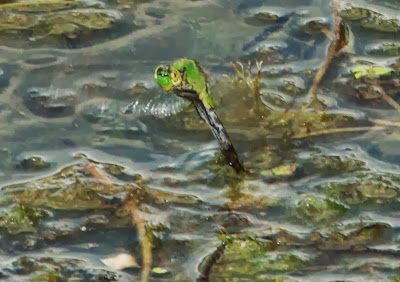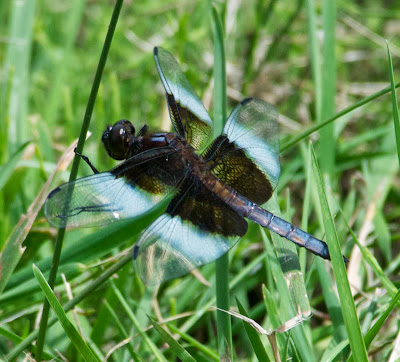A morning check of the boathouse (see previous post) revealed a just-emerged dragonfly clinging to its exuvium. It's a good place to start - though beyond identifying the dragonfly in question as a libellulid, I have no idea which species this one is.
Eastern Pondhawks (Erythemis simplicicollis) seem to my eye to have particularly long and narrow wings. Presumably, as in birds, variation in wing shape is an adaptation for differing types of aerobatic performance. One recent study suggests that both habitat choice and sexual selection have affected wing shape in at least one genus of dragonflies, Trithemis.
Note the heavy pruinosity on this male - a dusty blue fuzz that covers most of his body, except for his bright green face.
The female Eastern Pondhawk is a gorgeous insect, glowing in emerald green and far outshining the dusty-blue adult male.
Some females were busy ovipositing, flying low over the surface of the water and repeatedly dipping the tips of their abdomens below the surface - a momentary darting action, but one presumably lasting long enough to release an egg or two.
Here is a face-on view of a pair of mating pondhawks "in wheel".
One tipped itself into the "obelisk" position, supposedly a means of reducing overexposure to the sun but, I gather, one adopted even when the sun isn't shining. Blue Dashers in particular are known to adopt the obelisk position as part of a challenge to other males, as it shows off the blue of the abdomen to best advantage.
It took me a while to realize that these dark blue dragonflies were not simply duller Eastern Pondhawks but male Slaty Skimmers (Libellula incesta).
The giveaway is the face - blue here, green in the Pondhawk.
The strikingly-patterned Widow Skimmer (Libellula luctuosa) was a new species for me, though it is common enough in southern Ontario. This is a male.
Males dashed about in pursuit of each other and lesser dragonflies, giving me few chances to photograph them. A few. like this one, did manage to hold still long enough for me to take a portrait.
This male has presumably survived an attack by a bird. He appears to be a mature male – as the males age, they become more extensively light blue as the amount of pruinosity on the body increases.
Tom, Pat and I found a few female (or young male?) Widow Skimmers on the road through the woods behind the cottage, and in their own way they are as striking as the males.
With them was a female Common Whitetail (Plathemis lydia), an abundant species further north.
The road edge was the only place I found these bright little dragonflies; given our location, they are presumably Cherry-faced Meadowhawks (Sympetrum internum). They seemed to avoid the open lake. The adult male is bright vermilion; the yellow insects are females or, perhaps, young males.
Along the shore I found a few Dot-tailed Whitefaces (Leucorrhinia intacta), marked by a surprising yellow spot on the upper surface of the abdomen.
This male is perching, most attractively, on a clump of Selfheal (Prunella vulgaris).
This female I found flitting over the water, dropping eggs as she flew. You can see the ripples from her last bout of oviposition. Not a bad assortment, considering that all these photographs were taken within a few yards of each other. For still more species of dragonflies (and other things) I had to arrange farther afield – but that I will report on in my next post.



























+DSC_2471.jpg)



+DSC_2728.jpg)


+DSC_2710.jpg)
+DSC_2712.jpg)
No comments:
Post a Comment